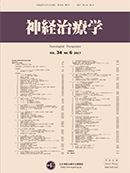Volume 37, Issue 4
Displaying 1-50 of 71 articles from this issue
-
2020Volume 37Issue 4 Pages 501-505
Published: 2020
Released on J-STAGE: May 27, 2021
Download PDF (397K)
-
2020Volume 37Issue 4 Pages 507
Published: 2020
Released on J-STAGE: May 27, 2021
Download PDF (172K) -
2020Volume 37Issue 4 Pages 508-512
Published: 2020
Released on J-STAGE: May 27, 2021
Download PDF (1205K) -
2020Volume 37Issue 4 Pages 513-516
Published: 2020
Released on J-STAGE: May 27, 2021
Download PDF (500K) -
2020Volume 37Issue 4 Pages 517-520
Published: 2020
Released on J-STAGE: May 27, 2021
Download PDF (1420K) -
2020Volume 37Issue 4 Pages 521-525
Published: 2020
Released on J-STAGE: May 27, 2021
Download PDF (841K) -
2020Volume 37Issue 4 Pages 526-530
Published: 2020
Released on J-STAGE: May 27, 2021
Download PDF (423K) -
2020Volume 37Issue 4 Pages 531-535
Published: 2020
Released on J-STAGE: May 27, 2021
Download PDF (1569K) -
2020Volume 37Issue 4 Pages 536
Published: 2020
Released on J-STAGE: May 27, 2021
Download PDF (171K) -
2020Volume 37Issue 4 Pages 537-542
Published: 2020
Released on J-STAGE: May 27, 2021
Download PDF (1700K) -
2020Volume 37Issue 4 Pages 543-547
Published: 2020
Released on J-STAGE: May 27, 2021
Download PDF (1543K)
-
2020Volume 37Issue 4 Pages 548-552
Published: 2020
Released on J-STAGE: May 27, 2021
Download PDF (442K) -
2020Volume 37Issue 4 Pages 553-557
Published: 2020
Released on J-STAGE: May 27, 2021
Download PDF (2251K) -
2020Volume 37Issue 4 Pages 558-561
Published: 2020
Released on J-STAGE: May 27, 2021
Download PDF (402K) -
2020Volume 37Issue 4 Pages 562
Published: 2020
Released on J-STAGE: May 27, 2021
Download PDF (159K) -
2020Volume 37Issue 4 Pages 563
Published: 2020
Released on J-STAGE: May 27, 2021
Download PDF (96K)
-
2020Volume 37Issue 4 Pages 564
Published: 2020
Released on J-STAGE: May 27, 2021
Download PDF (161K) -
2020Volume 37Issue 4 Pages 565
Published: 2020
Released on J-STAGE: May 27, 2021
Download PDF (214K) -
2020Volume 37Issue 4 Pages 566-570
Published: 2020
Released on J-STAGE: May 27, 2021
Download PDF (1042K) -
2020Volume 37Issue 4 Pages 571
Published: 2020
Released on J-STAGE: May 27, 2021
Download PDF (146K) -
2020Volume 37Issue 4 Pages 572-576
Published: 2020
Released on J-STAGE: May 27, 2021
Download PDF (1037K) -
2020Volume 37Issue 4 Pages 577-580
Published: 2020
Released on J-STAGE: May 27, 2021
Download PDF (423K)
-
2020Volume 37Issue 4 Pages 581
Published: 2020
Released on J-STAGE: May 27, 2021
Download PDF (281K) -
2020Volume 37Issue 4 Pages 582-583
Published: 2020
Released on J-STAGE: May 27, 2021
Download PDF (274K) -
2020Volume 37Issue 4 Pages 584-587
Published: 2020
Released on J-STAGE: May 27, 2021
Download PDF (398K) -
2020Volume 37Issue 4 Pages 588-590
Published: 2020
Released on J-STAGE: May 27, 2021
Download PDF (395K) -
2020Volume 37Issue 4 Pages 591
Published: 2020
Released on J-STAGE: May 27, 2021
Download PDF (215K)
-
2020Volume 37Issue 4 Pages 592-593
Published: 2020
Released on J-STAGE: May 27, 2021
Download PDF (341K) -
2020Volume 37Issue 4 Pages 594-596
Published: 2020
Released on J-STAGE: May 27, 2021
Download PDF (331K) -
2020Volume 37Issue 4 Pages 597-600
Published: 2020
Released on J-STAGE: May 27, 2021
Download PDF (1145K) -
2020Volume 37Issue 4 Pages 601-604
Published: 2020
Released on J-STAGE: May 27, 2021
Download PDF (439K) -
2020Volume 37Issue 4 Pages 605-608
Published: 2020
Released on J-STAGE: May 27, 2021
Download PDF (481K)
-
2020Volume 37Issue 4 Pages 609
Published: 2020
Released on J-STAGE: May 27, 2021
Download PDF (259K) -
2020Volume 37Issue 4 Pages 610
Published: 2020
Released on J-STAGE: May 27, 2021
Download PDF (200K) -
2020Volume 37Issue 4 Pages 611-613
Published: 2020
Released on J-STAGE: May 27, 2021
Download PDF (305K) -
2020Volume 37Issue 4 Pages 614-619
Published: 2020
Released on J-STAGE: May 27, 2021
Download PDF (1930K)
-
2020Volume 37Issue 4 Pages 620
Published: 2020
Released on J-STAGE: May 27, 2021
Download PDF (204K) -
2020Volume 37Issue 4 Pages 621-624
Published: 2020
Released on J-STAGE: May 27, 2021
Download PDF (743K) -
2020Volume 37Issue 4 Pages 625
Published: 2020
Released on J-STAGE: May 27, 2021
Download PDF (164K) -
2020Volume 37Issue 4 Pages 626-628
Published: 2020
Released on J-STAGE: May 27, 2021
Download PDF (573K) -
2020Volume 37Issue 4 Pages 629-633
Published: 2020
Released on J-STAGE: May 27, 2021
Download PDF (1087K)
-
2020Volume 37Issue 4 Pages 634
Published: 2020
Released on J-STAGE: May 27, 2021
Download PDF (250K) -
2020Volume 37Issue 4 Pages 635
Published: 2020
Released on J-STAGE: May 27, 2021
Download PDF (191K) -
2020Volume 37Issue 4 Pages 636-639
Published: 2020
Released on J-STAGE: May 27, 2021
Download PDF (421K) -
2020Volume 37Issue 4 Pages 640
Published: 2020
Released on J-STAGE: May 27, 2021
Download PDF (190K) -
2020Volume 37Issue 4 Pages 641
Published: 2020
Released on J-STAGE: May 27, 2021
Download PDF (180K)
-
2020Volume 37Issue 4 Pages 642
Published: 2020
Released on J-STAGE: May 27, 2021
Download PDF (252K) -
2020Volume 37Issue 4 Pages 643
Published: 2020
Released on J-STAGE: May 27, 2021
Download PDF (168K) -
2020Volume 37Issue 4 Pages 644-646
Published: 2020
Released on J-STAGE: May 27, 2021
Download PDF (483K) -
2020Volume 37Issue 4 Pages 647
Published: 2020
Released on J-STAGE: May 27, 2021
Download PDF (212K)
